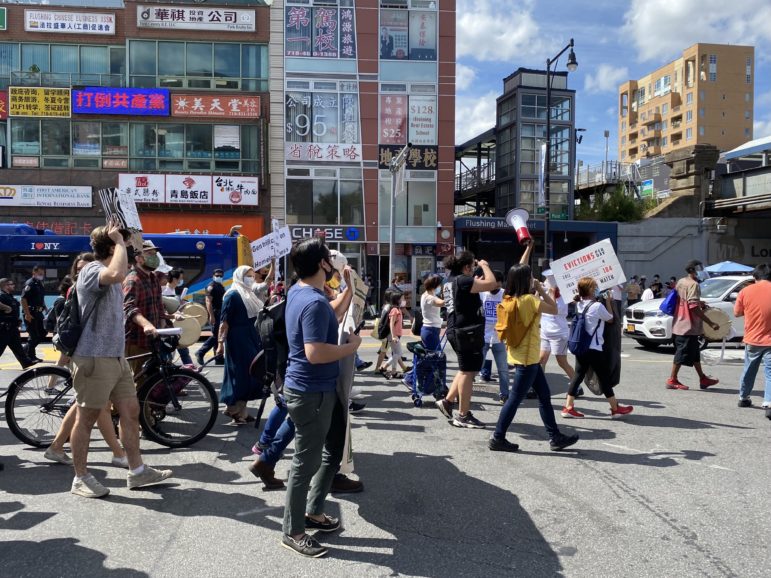Just five councilmembers voted against the land use application for the project, which has drawn the ire of critics who say it doesn’t include nearly enough affordable housing.

Sadef Ali Kully
Community groups who oppose the rezoning plan held a protest rally on Main Street in September.The City Council approved the Special Flushing Waterfront District private rezoning by 38 votes Thursday, despite community contention over the plan, which would develop the 29-acre site with nine new buildings, including 1,725 apartments and other facilities.
Just five councilmembers voted against the land use application: Inez Barron, Costa Constantinides, Brad Lander, Carlos Menchaca and James Van Bramer. Lander released a statement saying that, despite the developers coming to an agreement with local hotel and construction unions pledging good jobs with prevailing union wages, the plan lacked essential affordable housing.
“Organizing by community groups and labor unions, and leadership from my colleagues, has made the proposal better. And many of its shortcomings reflect broader failures of our land-use process. But it still does not meet the standards we should be setting for broadly-shared, equitable, and sustainable growth,” Lander’s statement reads. “Our city desperately needs more good jobs, more affordable housing, and more resilient infrastructure. Unfortunately, I believe the proposal that the Council is voting on today in Flushing fails at two out of three of those goals.”
Councilmembers Fernando Cabrera and Antonio Reynoso were nonvoting; there was one abstention by Councilmember Paul Vallone, and Councilmembers Margaret Chin and Bill Perkins were absent.
The group FWRA LLC, a partnership of three private developers, is behind the private application and owns the majority of the properties along the waterfront site. Of the 1,725 apartments planned for the project, just 70 to 95 would be affordable under the city’s Mandatory Inclusionary Housing (MIH) program. The development would also include a hotel, a new road system, public open space along the water, commercial space for retail and offices and a community center within a 11-block area east of Flushing Creek and west of Prince Street.
In a press statement, the developers said they are happy with the outcome and looking towards moving forward with the project.
The rezoning application includes a zoning text amendment and zoning map amendment to establish a Special Purpose District, both of which would allow for development for residential and commercial uses, with some light industrial uses. Zoning rules for an estimated 75 percent of the site would remain the same under the plan, where properties are currently zoned for commercial and residential use.
Flushing community groups, residents and stakeholders who oppose the rezoning expressed their frustration with the vote over social media. “Today we lost a big battle. The Council voted to displace thousands of Asian & Latinx immigrants whose labor & culture make Flushing what it is,” tweeted Bright Limm, a community activist.
“City Council has ignored us, pit us against each other, SOLD US OUT to multimillionaire developers and gave us crumbs in return by voting for @SFWDistrict. They used the pandemic as an excuse for a 10-year old DISASTER of a plan that WON’T save us. SHAME ON YOU,” tweeted the MinKwon Center, one of the Flushing organizations involved in a lawsuit against the rezoning.
Dozens of groups and over a 1,000 individuals signed a Dec. 3rd open letter to Councilmember Peter Koo, who represents the district and supports the rezoning, demanding he and City Council vote against the rezoning application.
“Living in the time of COVID-19 where thousands of people are lining up in Flushing for food,
businesses are shuttered, and residents face eviction, it is unconscionable to build more luxury housing and retail that will only further make life more precarious for its current residents and neighborhood,” read the letter. “We are in a moment where the status quo will not work any longer and there is no room for selling away our communities for more dollars.”
In June, a coalition of opponents to the plan filed a lawsuit against the Department of City Planning and the City Planning Commission, alleging the city must pursue a complete environmental review process for the project. It claims the city was incorrect to give the proposed waterfront development plan a negative declaration, meaning there would not be a significant impact from the project on the environment and therefore it did not need a detailed Environmental Impact Statement (EIS).
The coalition found that decision troubling, given the city’s own 2015 study of the area for a broader rezoning foresaw multiple potential environmental impacts (the city ultimately withdrew that proposal. The private rezoning application approved Thursday includes a portion of the area that was included in the city’s abandoned Flushing West rezoning plan.)
The de Blasio administration has unsuccessfully attempted to have the critics’ lawsuit dismissed. The next court date in the case is scheduled for January.









